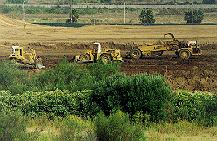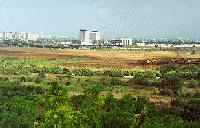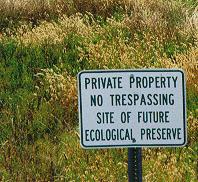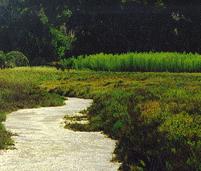August 1st, 1998
The Greening of Ballona - ET Stay Home
By Jackie Giuliano, Ph.D.
Wherever you are is home
And the earth is paradise
Wherever you set your feet is holy land . . .
You don't live off it like a parasite.
You live in it, and it in you,
Or you don't survive.
And that is the only worship of God there is.
-- Wilfred Pelletier and Ted Poole
The kind of green that the Ballona Wetlands is being covered with is not native to this
Earth. The green that now replaces the natural vegetation that has provided nurseries and
breeding grounds for wildlife and birds for centuries is the green of profit and greed.

Chewing Up The Ballona Wetland. Photos (c) Jackie Giuliano 1998.
Bulldozers have begun chewing up the 957-acre remnant of the last of Southern
California's once-rich estuarine ecosystem. In its place will be the largest development
project in Los Angeles' history. During its construction over the next decade, it will be
the largest construction project in the United States.
This development, located in Marina del Rey an already densely populated coastal city
adjacent to Santa Monica, will contain 13,000 condos and apartments and 6 million square
feet of commercial space. It is projected to house more than 30,000 permanent residents
and 20,000 daily workers.
The developers' own estimates reveal startling environmental impacts will result in the
region:
- The complex will add more than 200,000 car trips, generating 10 tons of air pollution
daily
- The development would be the fourth largest polluter in all of Los Angeles
- Critical habitat for endangered species would be lost and thousands of migrating birds
would lose one of the last remaining habits along the Pacific Flyway.
 The complexity of this issue is daunting, as are the financial investments. Deceit and
subterfuge seem to be the only constants. The hundreds of millions of dollars at stake and
the financial power of those involved has, until now, cleared all administrative hurdles.
The complexity of this issue is daunting, as are the financial investments. Deceit and
subterfuge seem to be the only constants. The hundreds of millions of dollars at stake and
the financial power of those involved has, until now, cleared all administrative hurdles.
Film director Steven Spielberg has been featured in this deal as well, his Dreamworks
organization having been courted to build their studio on the site.
Even the U.S. Army Corps of Engineers, the nation's wetland guardians, approved the
project without a complete environmental impact statement. But a federal judge on July 13,
1998 cast doubt on the integrity of the project by leaving intact his ruling, first given
a few weeks earlier, that the Corps of Engineers acted improperly by approving the
project. They must now conduct a more rigorous study that considers the impact of the
entire project on the wetlands.
 It is
difficult to even get a straight answer about how much acreage the area contains. The
developer will tell you that the site is 1,087 acres. But only 957 of those acres are
buildable - you see, the developer includes the surface area of Ballona Creek and the
sides of the surrounding bluffs in their estimates! This allows them to inflate their
numbers when they talk about how much area they are preserving. It is
difficult to even get a straight answer about how much acreage the area contains. The
developer will tell you that the site is 1,087 acres. But only 957 of those acres are
buildable - you see, the developer includes the surface area of Ballona Creek and the
sides of the surrounding bluffs in their estimates! This allows them to inflate their
numbers when they talk about how much area they are preserving.
The judge, in his 53-page ruling, agreed with a coalition of 80 citizen groups that the
Corps of Engineers failed to consider the cumulative impacts of the Playa Vista Project.
Yet this morning, as I drove around the site taking the pictures you see in this article,
the bulldozers were chewing up the once lush greenery. What's going on? I thought that the
judge said to stop grading the wetland. Well he did - and the bulldozers are not
technically grading the "wetland."
Section 404 of the U.S. Clean Water Act establishes a program to regulate the discharge of
dredge and fill material into our nation's waters, including wetlands.
Wetlands are recognized by our government for their critical role in providing food and
habitat for fish and wildlife, protection from floods and shoreline erosion, helping water
quality and in providing opportunities for recreation, education, and research.
 However, wouldn't you know it, the U.S. Environmental Protection Agency and the Army Corp
of Engineers have developed a rather restrictive definition of what a wetland is. Here is
their definition:
However, wouldn't you know it, the U.S. Environmental Protection Agency and the Army Corp
of Engineers have developed a rather restrictive definition of what a wetland is. Here is
their definition:
"Wetlands are areas that are inundated or saturated by surface or ground water at a
frequency and duration sufficient to support, and that under normal circumstances do
support, a prevalence of vegetation typically adapted for life in saturated soil
conditions. Wetlands generally include swamps, marshes, bogs, and similar areas."
This definition was developed with considerable input from industry in order to insure
minimum impact on development projects. Using this strict definition, the Corps of
Engineers has decided that out of the 957 acres of beautiful, vibrant, important open
space in the area known as the Ballona Wetlands, only 188 acres are "federally
delineated wetlands." Of those acres, only 16 are protected in the recent court
decision since they are the only ones that were to be graded under Phase 1 of the Playa
Vista Project. The bulldozers may chew up the rest, even while the environmental impact
statement is being researched over the next two years.

Say "Good-bye" to these marsh grasses.
When will it stop? When will enough be enough?
If any development takes place at all, it should be restricted to the 59 acres of paved
land once occupied by the Hughes Aircraft Company. California allowed Howard Hughes to buy
the land in the 1940s. Dreamworks could easily set up shop there.
When will we recognize the value of open space and its vital importance to our mental,
physical, and ecosystem health? When will we stop the two percent of our population who
control 80 percent of the wealth from pillaging our future? It had better be soon.
RESOURCES
1. Voices have risen to stop the rampant destruction of this remnant of our once healthy
ecosystem in a coalition of 80 groups, collected together by Marcia Hanscom into the
Wetlands Action Network (WAN). Join them in their battle. They can be reached at 29170
Heathercliff Rd., Suite 1, Malibu, CA 90265. Tel: 310-457-0300; Fax: 310-457-0302.
Donations for their legal battle are urgently needed. They can be e-mailed at wetlandact@earthlink.net
2. Learn what you can do from the Ballona Valley Preservation League at http://www.geocities.com/RainForest/Vines/7937/
3. Read a revealing article about the entire Ballona controversy in the New Times
newspaper at http://www.newtimesla.com/1998/073098/stewart1.html
4. See a recent press release by the Wetlands Action Network describing the controversy at
http://www.west.net/~srfrdrvc/html/lawless_bulldozing.html
and http://www.west.net/~srfrdrvc/html/ballona_victory.html
5. Learn how the U.S. government defines a wetland at http://www.epa.gov/OWOW/wetlands/facts/fact5.html
6. The history of the Ballona region can be found at http://eco.bio.lmu.edu/www.ballona/hist.htm
7. See a summary of the environmental impacts of the Playa Vista Project at http://www.life.net/wetlands/benvirneff.html
8. Find your Congressional representatives are and e-mail them. If you know your Zip code,
you can find them at http://www.visi.com/juan/congress/ziptoit.html or you can search by
state at http://www.webslingerz.com/jhoffman/congress-email.html
9. Write to California U.S. Senator Barbara Boxer senator@boxer.senate.gov and Debra Bowen Debra.Bowen@assembly.ca.gov. Urge them to
stop this project.
10. Boycott Dreamworks products, including Spielberg's movies. Tell them you are doing so
by calling 818-733-6336.
11. Learn about the issues. Seek out books on the subject. A good source for used (and
new) books is Powell’s Bookstore in Portland, Oregon at http://www.powells.com/cgi-bin/associate?assoc_id=212
where you will find a wonderful alternative to the massive chain bookstores taking over
the market. |
